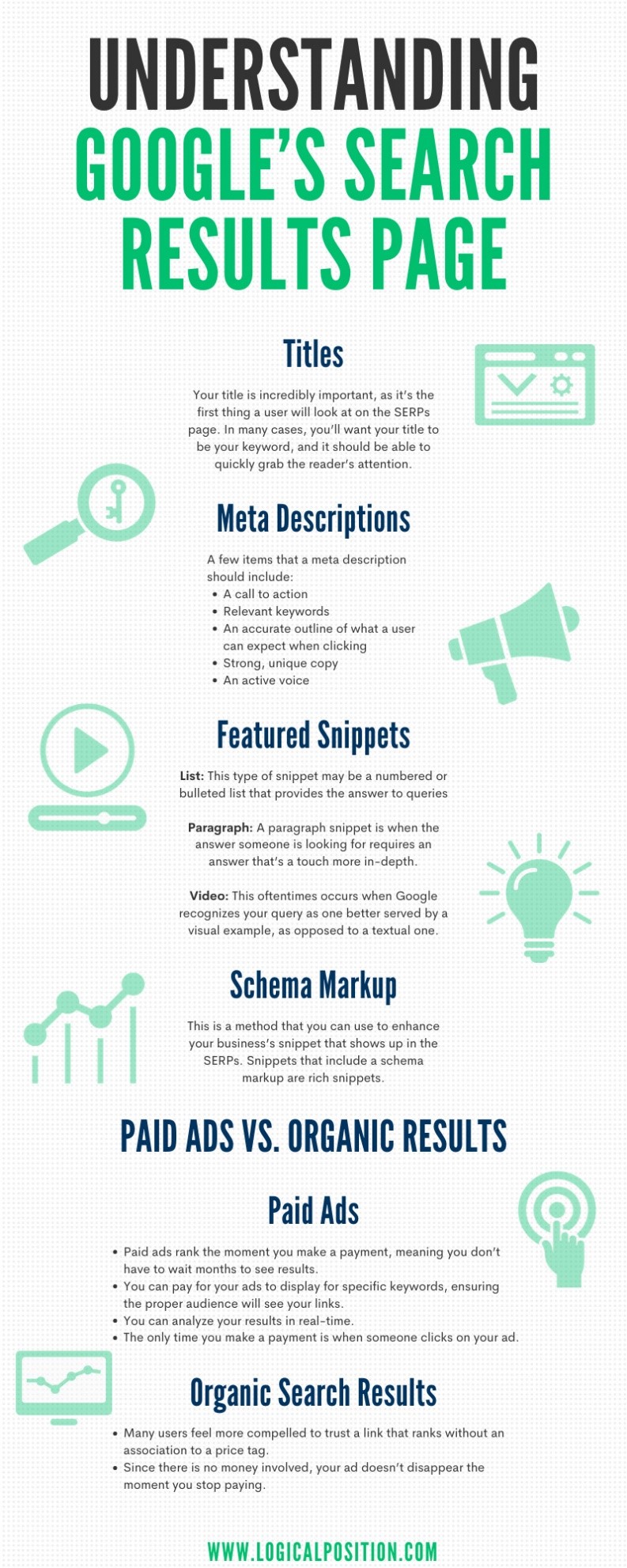Take a behind the scenes look at the enigma that significantly influences the success of a business. Use our guide to better understand how search engines work.
What is a Search Engine?
The World Wide Web is a behemoth, and we’d be completely unable to efficiently navigate it without the aid of a search engine. A search engine is a massive tool that filters through billions of pages to identify and display the ones that are most useful to a user’s query. The search engine is constantly evolving so that it can efficiently and accurately give users relevant results. When you have your own business, you want this tool to recognize your website for what it is and place it on the front page for the appropriate search term.
To not only drive traffic to your site but turn these clicks into conversions, it’s important to know the details of how a search engine works. Without this knowledge, a couple of things may happen. One of these is that your keywords could have a low rank, therefore causing your site to not show up anywhere near the first page of results. The other possibility is that, if your website shows up and isn’t relevant to a user’s query, they’ll quickly exit out of your site. This will negatively affect your bounce rate and cause you to lose a conversion.
To better understand how the modern search engine works, we created an overview of the several components that go into the way it curates results. The information below should help you evaluate your own website and determine how you can improve its place in the World Wide Web. Much of the content will contain information that focuses more so on Google than other engines, as it’s the most popular search engine on the web.
How Does a Search Engine Work?
The first thing to know is how the search engine works through the processes of crawling and indexing. Through this, the engine will work to appropriately rank pages so that it pulls up the most useful results. The very basics of crawling and indexing are as follows:
Crawling
- The best way to imagine crawling would be to visualize spiders spreading out amongst your website and collecting links as they go. When they find one link, they follow that path to discover and collect others. Once they find these links, they carry them over and store them in Google’s database.
- A good site navigation will make it easier for crawlers to navigate your site, which will help a search engine collect accurate information. The reason for this is that a search engine is keeping the ease of use for users in mind, and they aren’t likely to rank a site that’s difficult to navigate. You can improve crawling if you have a strong sitemap, as the information provided here will aid in the efficiency of the crawlers.
- There are certain instances in which a crawler can’t navigate your site, which can have a negative impact, though it depends on the occasion. A search engine will not crawl any pages that don’t go through indexing—and users can intentionally make it so certain pages don’t.
Indexing
- When crawlers pick up links from a site, they then proceed to index it, which essentially involves storing it into a massive database. A crawler must index a page to appear in the search engine—which means that a page that a crawl doesn’t index cannot show up for any searched queries.
- You can find out if you have an indexed site by using a “site:” before your website’s URL in the search bar. Essentially, if your site is “examplepage.com,” you want to enter “site:examplepage.com” into the search bar. When you type this in, a page with all your site’s indexed pages will appear.
- There are certain instances in which one may not want Google to index their site, which you can achieve by using the noindex tag. Site owners may choose to use a noindex on pages with thin content, such as an “about us” page or login pages.
How a Search Engine Generates Search Results
In this section, we outline what all a search engine looks for when it performs a search. The tasks a search engine performs in the fraction of a second between the time we hit enter and when the results page comes up seems near impossible. The below items are some of the key things a search engine looks at when trying to find the pages that will best serve a user’s needs.
Relevancy and Keywords
Keywords are what ultimately help a search engine rapidly filter through websites and identify useful pages. Every day, Google, the largest search engine, works toward perfecting the formula that transforms our query into results. Below are the highlights of keywords:
- Later in this article, we’ll discuss the anatomy of the search engine’s—specifically Google’s—results page. However, the first thing to know is that Google looks for keywords to curate this page. Keywords are a huge factor when it comes to the workings of search engine optimization. For example, if you sell used tires, you’ll want your page to show up when people search terms such as “used car tires,” “used snow tires,” or “inexpensive truck tires”. When users search these terms, Google pulls sites with authority from its index to show to users.
- When it comes to keywords, you may hear about short-tailed vs. long-tailed keywords. If you sell used tires, it’s a large market, therefore making it difficult to get one of the coveted top spots in the SERPs. In this case, you may want to focus on long-tailed keywords, as this narrows down the results and makes it more likely for someone to see your site and for a conversion to occur. For example, instead of targeting the keyword “used snow tires,” you may instead consider “used snow tires for a 2009 Honda Accord.”
Technical Aspects
Another item that Google looks for when performing a search is the various technical aspects of a site and how they influence the user’s experience. Two of the big things it will look at include the speed of a site as well as how mobile-friendly it is.
Page Authority
A page’s authority is extremely important when it comes to how it performs in the search engine. So, what is page authority, and how can you improve it?
Essentially, page authority is how an individual page looks in Google’s eyes, and this will influence its positions in the SERPs. It’s important to note the word page in page authority. How well a single page performs does not reflect the authority of the entire site—this would be domain authority.
One of the biggest ways to improve a page’s authority is through backlinking, which is when an external page will link back to a page on your site. Say we have the used tire site used as an example above, and 20 different websites have a link that directs to the same page on your website. When Google crawls these other pages, they take note of the fact that several people find that specific page about tires on your site to be useful. As a result, Google takes these votes of confidence and uses them to list your page higher in the SERPs.
An important part of any SEO campaign is the act of building backlinks by having other reliable websites point back at yours. As long as you follow the best white hat practices—which we elaborate on below—you may find your page authority begin to increase.
Local vs. National Searches
It’s important to be aware of how SEO works differently for local and national searches. There’s a difference between searching for a new pair of shoes and pizza delivery services, and Google wants to be able to differentiate these two different types of services. Google bases national searches on factors such as keywords and backlinks. While local searches can benefit from the same thing, there are a few other factors that come into play. These can include the following:
- Google My Business verification
- Clear contact information on your site
- How far your business is from the searcher’s location
- Location-based keywords
If you’re signing on with an advertising company and have a local business, it’s important to purchase a local package. Ignorantly advertising on a national level with a local business can result in wasted money and failure to reach your projected results.
Understanding Google’s Search Results Page
Now that you understand how Google manifests search results, you’ll want to learn about the anatomy of the search engine results page—or, as many know it, the SERPs. In this situation, we seek to give a basic overview of what it is you see on the search page, as well as how it may influence users.

Schema Markup
Schema markup is an SEO method that, tragically, many businesses underuse. This is a method that you can use to enhance your business’s snippet that shows up in the SERPs. Say we take our used tire business and make it a local one. To give the users more information about your business to help them decide whether or not to click on your page, you can add microdata to your HTML. This microdata helps Google not only read your content but better understand it. So, when users look up “used tire shop near me,” they may be able to see the number of reviews you have, as well as your address or phone number. Snippets that include a schema markup are rich snippets.
Titles
Your title is incredibly important, as it’s the first thing a user will look at on the SERPs page. In many cases, you’ll want your title to be your keyword, and it should be able to quickly grab the reader’s attention. Titles can be difficult because they have to be brief, concise, and unique. While there’s truly no set standard for titles, many recommend that you keep them between 40 to 60 characters or around 600 pixels. If you have too long a title, Google may cut it off, and it isn’t as likely to grab a user’s attention.
Meta Descriptions
A meta description is text added to an HTML that gives a brief description of the page you’re about to visit. This shows up below a page’s title in the SERPs. It’s important that the meta description relays vital information in only a few words. This should be compelling content, and you’ll want to be sure that it’s short enough that Google doesn’t cut it off in the SERPs—many meta descriptions sit between 140 to 160 characters. Below are a few items that a meta description should include:
- A call to action
- Relevant keywords
- An accurate outline of what a user can expect when clicking
- Strong, unique copy
- An active voice
Featured Snippets
Another thing you may oftentimes find on a search page is a featured snippet. This is a box that appears at the top of the search page to quickly give users the answer they’re looking for. Pages that earn the featured snippet spot for a specific search term may see a major influx in traffic. As such, it’s incredibly valuable for anyone with an SEO campaign to use the practices required to receive one. There are a few different types of featured snippets, which are as follows:
- List: This type of snippet may be a numbered or bulleted list that provides the answer to queries such as “common symptoms of a cold” or “the best museums in Chicago.”
- Paragraph: A paragraph snippet is when the answer someone is looking for requires an answer that’s a touch more in-depth. For example, they may search phrases such as “what does a carpenter do” or “what is a featured snippet.” Google may scan an article for the appropriate keywords and display a paragraph that condenses all pertinent information in one line.
- Video: In some cases, you may come across a video as opposed to a text snippet. This oftentimes occurs when Google recognizes your query as one better served by a visual example, as opposed to a textual one. An example of a search that pulls up a video snippet may be “how to cut your own bangs.”
Paid Ads vs. Organic Results
When you type in a search term, you’ll oftentimes see sponsored results before organic ones. You can acquire paid searches through PPC, while you use SEO to improve your rankings with organic results. Below are a few pros of each option:
Paid Ads
- Paid ads rank the moment you make a payment, meaning you don’t have to wait months to see results.
- You can pay for your ads to display for specific keywords, ensuring the proper audience will see your links.
- You can analyze your results in real-time.
- The only time you make a payment is when someone clicks on your ad.
Organic Search Results
- Many users feel more compelled to trust a link that ranks without an association to a price tag.
- Since there is no money involved, your ad doesn’t disappear the moment you stop paying.
About Google Algorithms
Google algorithms are a monster of a topic, and it can take hours to fully understand the many nuances behind them. Fortunately, even the most basic understanding can help you improve your SEO campaign. In a few words, a search algorithm is a tool that filters through the billions of webpages in their index to find the most relevant results. Google consistently introduces updates into its algorithm to provide human, user-friendly results. Some of the things the algorithm accounts for include the following:
- Keywords
- Location
- Settings
- Authoritative pages
About Updates
Google updates its algorithm regularly. As such, it’s difficult for us to know every single detail about each update, but they each impact the way the searching process works. For some, larger updates can have an extremely negative impact on their website; however, one can generally determine this by whether or not you’re following the best practices. One striking example of this is the Google Medic Update.
The Medic Update was a massive Google update that launched in August of 2019. Many of the sites affected by this update were sites that sold products related to medical purposes. Though Google did not create the update to target only medical-related sites, it was many of these that took a major hit. The reason for this is that Google wants to promote websites with quality and credibility. Any websites that promote products that could compromise one’s health or offer results without a professional’s approval, will take a hit for not positively impacting on users. Websites that practiced white hat SEO had little cause to worry about this update, as they would remain relatively unaffected.
White Hat SEO
If you want to improve your results in the SERPs but don’t have a basic understanding of white hat SEO, it’s best to first perform relevant research. Then, evaluate whether or not your website follows these rules. Anyone who wants to keep their rankings and improve traffic should know the difference between white, grey, and black hat SEO. The following is a short overview of each:
- White Hat SEO: when one practices white hat SEO, they create content with the user’s experience as their top priority. To consider your work to follow white hat practices, you have to play by Google’s rules. White hat includes factors such as creating quality content regularly, using keywords only when appropriate and paying attention to your sitemap. Content should be clear, accurate, and easy to understand.
- Gray Hat SEO: grey hat SEO means that a website owner is walking the fine line when it comes to Google’s rules. They play along to pass, but Google may also penalize them if they aren’t careful. It’s likely anyone practicing gray doesn’t use links inappropriately—they just aren’t quite hitting the mark well enough to qualify as white hat practices.
- Black Hat SEO: anyone practicing black hat does not look good in Google’s eyes, and they’re the ones an update will most likely negatively impact. This involves factors such as poor-quality content, keyword stuffing, and buying links.
Can I Avoid Updates?
We can’t say that you can completely avoid one of Google’s updates, as no one can accurately predict what will come out. However, practicing white hat SEO is the best way to guard yourself against negative effects. Ultimately, each update Googles released has the intent of improving the user’s experience. So, if this is your primary goal, it’s safe to expect that your site will remain relatively free of any negative consequence.
Let LP Improve Your Rankings
The workings of a search engine are massive, and it’s difficult to dive into the deep details in a mere few thousand words. However, we hope that the above overview is enough to provide you with the basic understanding you need to move forward with a marketing strategy.
At Logical Position, we have an extensive team of professionals that are ready to help you show Google what it really is that you’re selling, as well as give them a reason to put you on that first page. When you sign on with Logical, we will pair you with an account manager that will focus their attention on your individual needs. We do all our work in-house, so we can be sure that we’re giving you quality results. Plus, we provide access to a client dashboard that updates you daily.
If you contact us today, we’ll set up a free review call during which we’ll look over your current rankings and pinpoint various areas of opportunity. We’ll also go over any marketing strategies you used in the past and offer a full education on how we’ll work to improve your Google rankings. From there, we’ll set up a package and help you get your business noticed. Our professionals are waiting for your call, so don’t wait to get in touch!

Logical Position, an Inc. 500 digital agency supporting 5,000+ clients across North America. LP is the proud recipient of Google’s Lead Generation Premier Partner of the Year and Microsoft's Global Channel Partner of the Year 2024! The award-winning agency offers full-service PPC management, SEO, Paid Social, Amazon and Creative Services for businesses large and small. As a Google Premier Partner, Microsoft Elite Partner & Meta Business Partner, LP is in the top 1% of ad spend managed across platforms.



